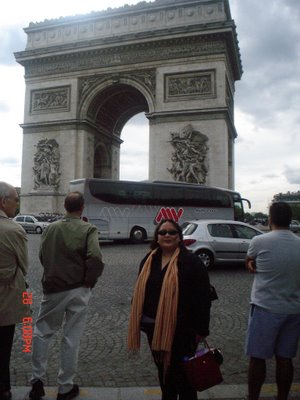Musee de Louvre (June 16, 2006)

My flight to NY was early evening but we still managed to insert a visit to Louvre. Bebeth has not yet seen it and I wanted to check out further the remaining tracks of the Da Vinci Novel.
Note: This leg was after our almost 23rd day of travel around France, Belgium, Germany and Austria.
I just had time to have a photo at the Inverted Pyramid, the three famous works of art Venus de Milo, Winged Victory of Samothrace and Mona Lisa of course plus the Virgin of the Rocks made famous by Dan Browns novel.
After an hour more or less I had to run back to the hotel, took a very quick lunch and ran off to the airport. Bebeth stayed on still her flight to manila was much later than mine.
Royal Palace Grounds (Palais Royale)
The Louvre Museum (Musée du Louvre) is said to be the largest museum in the world.
Built as a fortified royal palace for Philip Augustus in the centre of Paris and in the axis of the Champs-Élysées, parts of it were first opened to the public as a museum on November 8, 1793, during the French Revolution. The central courtyard, occupied by the Louvre Pyramid built in 1989, serves as the main entrance to the museum.



The Inverted Pyramid
I actually never noticed this the past times I have visited the museum but after reading and watching the Dan Brown Novel, I had to find where it was!

 La Pyramide Inversée was designed by architects I.M. Pei, Cobb Freed and Partners, and installed as part of the Phase II government renovation of the Louvre Museum. It was completed in 1993. In 1995, it was a finalist in the Benedictus Awards, described by the jury as "a remarkable anti-structure … a symbolic use of technology … a piece of sculpture. It was meant as an object but it is an object to transmit light."
La Pyramide Inversée was designed by architects I.M. Pei, Cobb Freed and Partners, and installed as part of the Phase II government renovation of the Louvre Museum. It was completed in 1993. In 1995, it was a finalist in the Benedictus Awards, described by the jury as "a remarkable anti-structure … a symbolic use of technology … a piece of sculpture. It was meant as an object but it is an object to transmit light."The Inverted Pyramid rose to sudden fame in 2003–2004 because it figures prominently on the concluding pages of Dan Brown's international bestseller The Da Vinci Code. The author, or rather the protagonist of his novel, reads esoteric symbolism into the two pyramids: The Inverted Pyramid is perceived as a Chalice, a feminine symbol, whereas the stone pyramid below is interpreted as a Blade, a masculine symbol: the whole structure could thus express the union of the genders. Moreover, Brown's protagonist concludes that the tiny stone pyramid is actually only the apex of a larger pyramid (possibly the same size as the inverted pyramid above).
It should be noted, however, that the now-famous description provided in the novel is not in all respects accurate (irrespective of the claim that the stone pyramid "protrudes up through the floor" rather than simply sitting on top of the floor). On one point, Brown's description is indeed self-contradictory. He rightly describes the stone pyramid as being three feet tall and "almost touching" La Pyramide Inversée above, yet he also says that the tip of the pyramid is suspended "six feet above the floor": If so, there would necessarily be three feet between the tips of the pyramids, in which case they could hardly be described as "almost touching" one another. Actually the tip of La Pyramide Inversée is closer to the floor than six feet (rather, as noted above, 4.5 feet), so that it does indeed hover right above the tip of the three-feet stone pyramid below.
 Winged Victory of Samothrace
Winged Victory of SamothraceThe winged goddess of Victory standing on the prow of a ship overlooked the Sanctuary of the Great Gods on the island of Samothrace.
The sculpture was offered by the citizens of Rhodes in commemoration of a naval victory in the early second century BC.
The monument combines a theatrical stance, vigorous movement, and billowing drapery of the Greek sculpture and refers to the Classical period-prefiguring the baroque aestheticism of the Pergamene sculptors.

According to the Louvre website "This exceptional monument was unearthed in 1863 on the small island of Samothrace in the northwest Aegean.
It was discovered by Charles Champoiseau, French Vice-Consul to Adrianople (Turkey). The goddess of Victory (Nike, in Greek) is shown in the form of a winged woman standing on the prow of a ship, braced against the strong wind blowing through her garments.
With her right hand cupped around her mouth, she announced the event she was dedicated to commemorate. The colossal work was placed in a rock niche that had been dug into a hill; it overlooked the theater of the Sanctuary of the Great Gods.
This niche may also have contained a pool filled with water in which the ship appeared to float. Given its placement, the work was meant to be viewed from the front left-hand side; this explains the disparity in sculpting technique, the right side of the body being much less detailed. The highly theatrical presentation-combined with the goddess's monumentality, wide wingspan, and the vigor of her forward-thrusting body-reinforces the reality of the scene. "


Venus de Milo
Sometimes known as Aphrodite, godess of love, the graceful statue has intrigued and fascinated many since its discovery on the island of Melos in 1820.
Some people wonder if she is Aphrodite, who was often portrayed half-naked, or the sea goddess Amphitrite, who was venerated on Milo.
The sculpture reflects research during the late Hellenistic Period - basically classical , with new features such as the spiral composition, the positioning in space, and the fall of the drapery over the hips.

 " The Venus de Milo was discovered in 1820 on the island of Melos (Milo in modern Greek) in the south-western Cyclades. The Marquis de Rivière presented it to Louis XVIII, who donated it to the Louvre the following year.
" The Venus de Milo was discovered in 1820 on the island of Melos (Milo in modern Greek) in the south-western Cyclades. The Marquis de Rivière presented it to Louis XVIII, who donated it to the Louvre the following year. The statue won instant and lasting fame. Essentially two blocks of marble, it is comprised of several parts which were sculpted separately (bust, legs, left arm and foot) then fixed with vertical pegs, a technique which was fairly common in the Greek world (especially in the Cyclades, where this work was produced around 100 BC). The goddess originally wore metal jewelry — bracelet, earrings, and headband — of which only the fixation holes remain. The marble may have been embellished with (now faded) polychromy. The arms were never found. " Virgin of the Rocks
Virgin of the Rocks
One of the minor paintings in Louvre but took a center stage when the novel Da Vinci code came out.
The museum curator in this novel kept a most important key at the back of this painting.
This work of art was commissioned by the Confraternité of the Immaculate Conception for a vault of the church San Francesco Grande in Milan. It seems however that there were two such paintings done and the original one maybe kept in London.
The second version (that in London) would have been painted under the control of Léonard by Ambrogio de Predis between 1495 and 1508 to replace the original one.
An ambiguous iconography The comparison of the two versions of the Virgin to the rocks shows well ambiguities of the iconographic program of the first, which was commented on much by the specialists. The identity of the characters can indeed appear obscure because of absence of attributes and the preeminence of the small Jean saint, placed at the sides of the Virgin, designated by the finger of the Gabriel archangel and blessed by Jesus.
The identity of the characters can indeed appear obscure because of absence of attributes and the preeminence of the small Jean saint, placed at the sides of the Virgin, designated by the finger of the Gabriel archangel and blessed by Jesus.
The traditional desert where the meeting held on the two children of divine design is, is replaced by a supernatural decoration of cave and rocks, water and plants.
It is the mystery of the Incarnation which is celebrated, through the role of Mary and that of the Precursor, which is considered according to a tradition florentine a playmate of Jesus, who was already aware of the sacrifice to come.
This prefiguration of Passion seems also contained in the representation of the chasm at the edge of which the Child and in the vegetation symbolic system is held which surrounds it (aconite, palms, iris).
 Mona Lisa
Mona Lisa
Portrait of Lisa Gherardini, wife of Francesco del GiocondoBetween 1503 and 1506
Unlike the past years, the Mona Lisa painting is now well guarded and fenced from the ever growing curious crowd.
Photos are a no no unlike before but of course I still managed to steal a shot :)
 Under the Pyramid
Under the Pyramid(Napoleon Hall)
Escalator going up the 1st floor where the more popular masterpieces.

The Louvre Pyramid is a large glass pyramid commissioned by then French president François Mitterrand.
The pyramid itself reaches a height of 20.6 metres (about 70 feet); its square base has sides of 35 metres (115 feet). The pyramid covers the Louvre entresol and forms part of the new entrance into the museum

 All over this vast complex, one can see the influence of the pyramid.
All over this vast complex, one can see the influence of the pyramid.From the outside fountain....


from all sides.....

Succeding photos taken inside the main museum, some shots stolen for in many plac
 es photography is foridden.
es photography is foridden.










